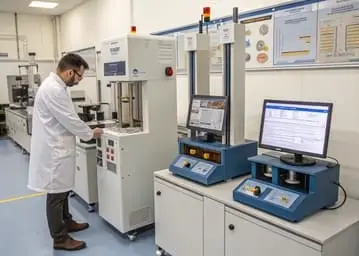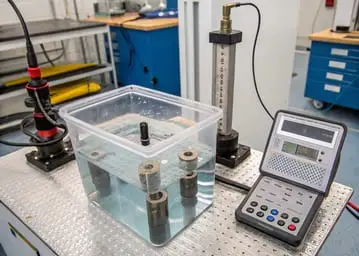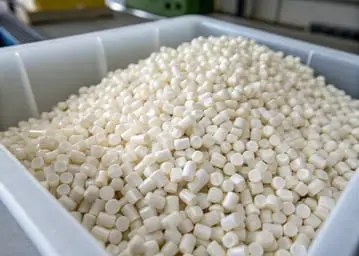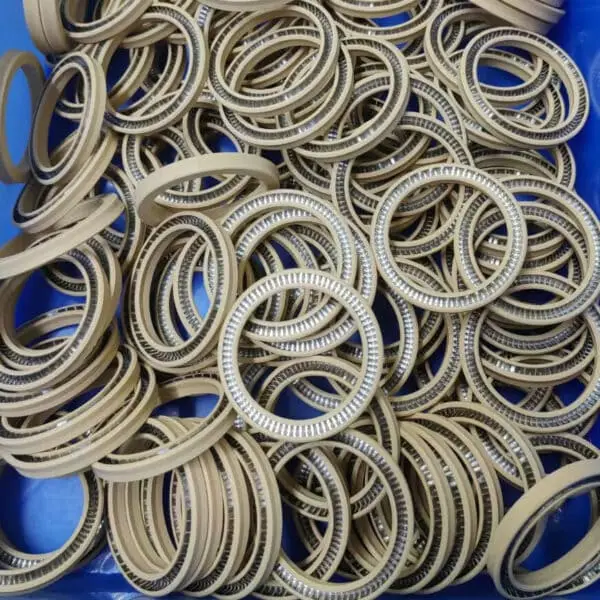What is a PEEK seal?
Are your seals failing under extreme heat or aggressive chemicals? Standard seals often break down in tough conditions. This leads to costly equipment failures and leaks. You need a material that can handle these extremes.
PEEK seals1 are high-performance sealing parts made from Polyetheretherketone. This is a strong thermoplastic plastic. It resists heat and chemicals very well. This makes PEEK seals ideal for tough industrial jobs where other materials might fail.
Choosing the right seal material is really important for keeping machinery running reliably. Here at FLUIDMEC in China, I’ve seen many expensive problems happen just because the wrong seal material was chosen. Understanding advanced materials like PEEK helps prevent these issues. Let’s look closer at what makes PEEK seals special and where they fit best, especially for B2B buyers looking for quality hydraulic seals.
What is the difference between PTFE and PEEK seals?
Do your PTFE seals2 wear out too fast or deform under high pressure? While PTFE (often called Teflon™ ) is good for many jobs, it might not be strong enough for very high pressures or temperatures. This can cause leaks or failures. You might need something tougher.
PEEK seals generally have much better mechanical strength, stiffness, and wear resistance than PTFE seals, especially when it gets hot . PTFE resists more chemicals and is slipperier , but PEEK is often the better choice for seals that take heavy loads or high stress, like in high-pressure valves .
Diving Deeper into PEEK vs. PTFE
Comparing PEEK and PTFE means looking at two excellent plastics . They are both top performers, but they are suited for different tasks. At FLUIDMEC, helping customers choose between them is a common part of our job, especially for hydraulic and oil seal applications.
- Temperature Resistance: Both handle high temperatures well, often rated up to around 260°C. However, PEEK keeps its strength and shape much better at these high temperatures . PTFE can start to soften or ‘creep’ (slowly deform) under load when it’s hot . PEEK can even handle short periods above 300°C . For very stable performance in hot, high-pressure conditions, like a pressurized steam seal, PEEK is usually more reliable because it won’t deform as easily . For very cold temperatures, PTFE’s flexibility can be good , although special PEEK grades exist too.
- Mechanical Strength & Pressure: This is a big difference. PEEK is much stronger and stiffer than PTFE . Its tensile strength is about 90-100 MPa, compared to PTFE’s 25-35 MPa . PEEK also resists creep much better . This means under high pressure, PEEK seals hold their shape and don’t get squeezed out of place easily . This is critical in high-pressure hydraulic systems or valves, maybe hundreds of bar . For example, in oilfield tools working at 20,000 psi, PEEK seal rings are standard because PTFE would likely fail unless supported . PTFE seals often need metal springs or special designs (like backup rings, sometimes made of PEEK!) to handle high pressure . If your seal needs to handle high loads or pressure without deforming, PEEK is usually the better choice .
- Chemical Resistance: PTFE is famous for resisting almost all chemicals . PEEK also has excellent chemical resistance3 to things like oils, hydrocarbons, and most solvents, even when hot . However, PEEK can be attacked by some very strong chemicals, especially concentrated sulfuric acid (which can dissolve it!) and other strong oxidizing acids or halogens, particularly at high temperatures . So, if you need a seal for extremely aggressive chemicals, PTFE is often the safer choice . For most industrial fluids, both are usually fine .
- Friction and Wear: PTFE is extremely slippery, with one of the lowest friction coefficients known (around 0.05) . PEEK has higher friction (around 0.35) . This makes PTFE great for dynamic seals, like rotating shaft seals, where low friction reduces heat and wear . PEEK, however, generally has better wear resistance, especially against abrasion, meaning it can last longer in applications where rubbing occurs, provided friction isn’t the main concern .
- Cost: PEEK is significantly more expensive than PTFE . If PTFE can do the job reliably, it will save costs .
Here’s a quick summary table based on what we see:
| Feature | PEEK | PTFE (Teflon™) |
|---|---|---|
| Max Temperature | ~260°C (Keeps strength better) | ~260°C (Can soften/creep under load) |
| Strength/Stiffness | Very High | Moderate |
| Pressure Limit | Very High (e.g., 20k psi+) | Moderate (Needs support at high P) |
| Creep Resistance | Excellent | Fair (Can cold-flow) |
| Chemical Resistance | Excellent (Avoid strong acids/halogens) | Exceptional |
| Friction | Moderate (~0.35) | Very Low (~0.05) |
| Wear Resistance | Excellent | Good (Improved with fillers) |
| Cost | High | Moderate |
The choice really depends on the specific job. For high loads, high temperatures, high pressures, and where dimensional stability is critical, PEEK is often worth the extra cost .
Why is PEEK so expensive?
Are you surprised by the high cost of PEEK seals or parts? The price can seem very high compared to other plastics, making you wonder if the performance justifies the expense .
PEEK is expensive mainly because making the raw chemical ingredients and the PEEK plastic itself is a complex and costly process . Also, its outstanding performance in extreme conditions means it commands a premium price in the market .
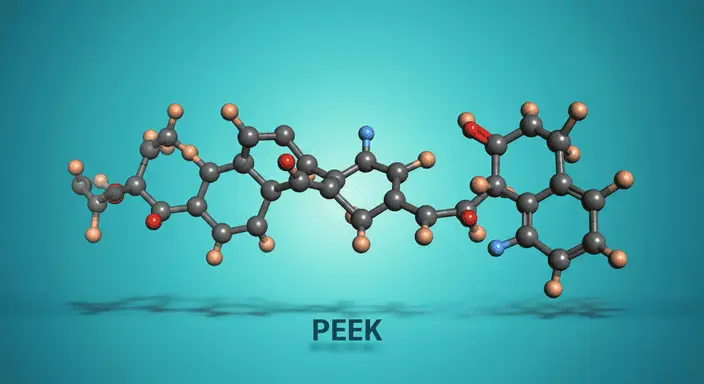
Diving Deeper into PEEK’s Cost Factors
The high cost of PEEK is something we often discuss with our B2B customers at FLUIDMEC. While its performance is undeniable , the price needs understanding. Several key factors contribute to PEEK being a premium material :
- Complex Raw Materials: The basic chemicals needed to make PEEK aren’t simple commodities. They require multiple, precise chemical reactions using specialized equipment and often expensive starting materials. Purifying these ingredients adds further cost.
- Difficult Polymerization: Creating the long PEEK polymer chains is a sophisticated process. It needs very accurate control of temperature and reaction conditions, often using special solvents. This process is energy-intensive and technically demanding compared to making simpler plastics like polyethylene or PVC.
- High Processing Needs: PEEK has a very high melting point (around 343°C). Turning PEEK resin into finished parts like seals requires machinery that can safely handle these extreme temperatures . Standard plastic processing machines often aren’t suitable, meaning higher investment and operating costs for manufacturers who shape PEEK components . It’s sometimes machined more like a metal than a typical plastic .
- Premium Performance Justifies Price: PEEK offers a rare combination of high heat resistance, excellent mechanical strength, broad chemical resistance, and great wear and creep resistance . Few other plastics can match this overall profile. Because it solves problems in applications where other materials fail (saving costly downtime or redesigns) , the market accepts a higher price for this capability.
- Lower Production Volumes: Compared to common plastics, the global production volume of PEEK is much smaller. This means fewer economies of scale in manufacturing, keeping the cost per kilogram relatively high . It remains a niche polymer for demanding applications .
So, while the upfront cost of a PEEK seal is high, think about the total cost of ownership. Its long life and reliability in tough environments often mean fewer replacements, less maintenance, and less costly downtime. It’s an investment in avoiding failure .What material is similar to PEEK?
Are you looking for PEEK-like performance but need to explore alternatives? Maybe the budget is tight, or you need one specific property slightly different from PEEK. What other high-performance plastics come close?
Materials like PEKK (Polyetherketoneketone), other polymers in the PAEK family, PPSU (Polyphenylsulfone), and PEI (Polyetherimide) offer high heat and chemical resistance. They can sometimes approach PEEK’s abilities but usually have trade-offs in mechanical strength, temperature limits, or cost.Alternative High-Performance Polymers Diving Deeper into PEEK Alternatives
PEEK is well-known for its excellent balance of properties , but it’s not the only high-performance polymer out there. At FLUIDMEC, we know the landscape of advanced materials. Sometimes, another option might be suitable if PEEK seems like overkill or isn’t the perfect match for every single requirement.
- Other PAEK Family Polymers: PEEK belongs to the Polyaryletherketone (PAEK) family. This group includes:
- PEKK (Polyetherketoneketone): Can offer even higher temperature resistance and sometimes greater strength than PEEK. However, it can be harder to process and is typically even more expensive. Its properties can vary depending on its specific chemical structure.
- PEK (Polyetherketone): Generally similar to PEEK but often with slightly lower overall performance, particularly in thermal capabilities.
- Sulfone Polymers (PSU, PESU, PPSU):
- PPSU (Polyphenylsulfone): Known for excellent resistance to repeated steam sterilization (hydrolysis resistance), high toughness, and good chemical resistance. Its maximum operating temperature and mechanical strength are generally lower than PEEK’s.
- PESU (Polyethersulfone): Offers good temperature resistance and stability but is typically less tough and less chemically resistant than PPSU or PEEK.
- PSU (Polysulfone): The most basic sulfone polymer, providing good properties but generally lower performance than PESU and PPSU.
- PEI (Polyetherimide) (Common trade name: Ultem™): Delivers high strength, stiffness, and good temperature resistance, along with fairly broad chemical resistance. However, its performance usually falls short of PEEK, especially concerning maximum temperature and wear resistance. It’s often a more cost-effective alternative if PEEK’s full capabilities aren’t needed.
- PPS (Polyphenylene Sulfide): Valued for its excellent chemical resistance (especially to solvents) and dimensional stability at high temperatures. It’s often reinforced with glass or carbon fiber to boost strength. Unfilled PPS typically doesn’t match PEEK’s mechanical strength or temperature limits.
Here’s a simplified comparison focusing on potential trade-offs versus PEEK:
| Material | Key Strengths | Potential Downsides Compared to PEEK |
|---|---|---|
| PEKK | Potentially higher temp/strength | Harder to process, higher cost |
| PPSU | Excellent steam resistance, tough | Lower max temp, lower mechanical strength |
| PEI | Good strength/stiffness, often lower cost | Lower max temp, lower wear resistance |
| PPS | Excellent chemical resistance, dimensionally stable | Lower strength/temp (if unfilled) |
The best choice depends heavily on the specific application needs: What temperature? Which chemicals? How much load or pressure? Is impact resistance important? And what’s the budget? While these materials are in the same high-performance category, none offers the exact same balanced property profile as PEEK .
What is PEEK used for?
Are you wondering where this impressive but expensive material actually gets used? Its great properties suggest tough jobs, but what specific parts rely on PEEK in the real world, especially in industries relevant to us at FLUIDMEC?
PEEK is used in critical parts across demanding industries like aerospace, medical, automotive, oil & gas, and industrial manufacturing . Common uses include high-performance seals , backup rings , valve seats , bearings, pump parts, electrical insulators , and medical implants, all thanks to its strength, heat/chemical resistance, and durability.
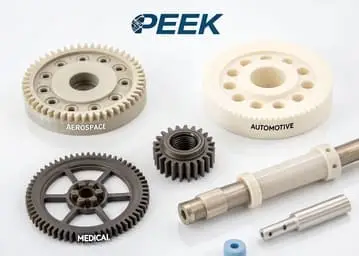
Diving Deeper into PEEK Applications
PEEK’s unique mix of properties makes it the material of choice when components face extreme conditions . At FLUIDMEC, we specialize in hydraulic seals and oil seals , so we see PEEK used extensively in sealing solutions, but its applications are much broader.
- Sealing Solutions (Our Focus):
- Valve Seats & Seals: PEEK excels here due to its ability to seal tightly under high pressure and temperature while resisting wear and aggressive fluids 1. It’s often used in ball valve seats and stem seals for demanding service. It handles higher pressures than unsupported PTFE .
- Backup Rings (Anti-Extrusion Rings): PEEK’s high stiffness and strength make it perfect for backup rings . These rings sit behind softer seals (like rubber O-rings or PTFE seals) in high-pressure hydraulics, preventing the main seal from being squeezed (extruded) into the gap . This is a very common application in hydraulic cylinders and valves.
- Hydraulic & Pneumatic Seals: PEEK piston rings, guide rings, and rod seals are used where high loads, temperatures, or aggressive fluids are present .
- Compressor Components: PEEK valve plates, rings, and seals offer longer life and better efficiency in gas compressors.
- Oil & Gas Seals: Essential for downhole tools (packers, safety valves, connectors) operating under extreme heat, pressure (like 20,000 psi ), and corrosive chemicals (H2S, CO2, hydrocarbons) . PEEK connector insulators are also common .
- Composite Gaskets: PEEK can be combined with PTFE in gaskets to leverage PEEK’s strength and PTFE’s sealing ability .
- Other Industrial Uses:
- Bearings, Bushings & Thrust Washers: Especially filled PEEK grades offer low wear and can run without lubrication.
- Gears: Lightweight, quiet, and durable gears for various machines.
- Pump Components: Impellers, wear rings, and housings resist chemicals and wear.
- Aerospace: Lightweight structural parts, thermal insulators, connectors .
- Medical: Biocompatible grades for spinal implants, surgical tools, dental applications .
- Automotive: Engine parts, transmission components (thrust washers, seal rings), braking systems .
- Electronics/Semiconductor: Wafer handling parts, insulators, test sockets due to purity and stability.
Essentially, PEEK gets chosen when other plastics can’t handle the combination of heat, chemicals, and mechanical stress , and where metals might be too heavy, prone to corrosion, or harder to fabricate into complex shapes .Is PEEK plastic strong?
Are you thinking about using PEEK for a part that needs to carry a load or withstand high pressure? You need to know if it’s truly strong enough for demanding mechanical tasks. How does it really stack up?
Yes, PEEK is exceptionally strong for a plastic . It has high tensile strength (resists pulling apart) and stiffness (resists bending), and importantly, it keeps these properties even when hot, unlike many other plastics . It also resists fatigue and creep (slow deformation under load) very well .PEEK Material Strength Testing Diving Deeper into PEEK’s Strength
When engineers, like us at FLUIDMEC making robust seals, talk about "strength," they mean several specific things. PEEK performs well across the board, making it suitable for parts that do real work .
- Tensile Strength: This measures how much pulling force PEEK can take before breaking. Unfilled PEEK typically handles around 90-100 MPa . This is very high for a plastic and means it won’t easily snap under tension. Adding reinforcements like carbon or glass fibers can push this even higher.
- Stiffness (Flexural Modulus): This shows how much PEEK resists bending under load. PEEK is very stiff (Flexural Modulus around 3900 MPa ), much stiffer than flexible plastics like PTFE (around 495 MPa ). This stiffness is crucial for seals that need to maintain their shape under pressure to prevent leaks, or for parts like backup rings that provide structural support .
- Compressive Strength: PEEK is also very strong when squeezed, which is important for seals and bearings constantly under pressure .
- Fatigue Strength: PEEK resists breaking after being loaded and unloaded many times. This is important for parts in machinery that experience vibration or cyclic loads.
- Creep Resistance: This is a major advantage of PEEK. Creep is the tendency of a material to slowly deform over time under constant stress, especially when hot. PEEK resists creep extremely well, much better than PTFE which can ‘cold-flow’ or deform significantly under sustained load . This means PEEK parts maintain their dimensions accurately over long periods, vital for reliable sealing .
- Hardness: PEEK is a hard plastic . This contributes to its wear resistance but also means it might require more precise mating surfaces compared to softer, more conforming seals like PTFE .
Because PEEK is so strong and rigid, it’s often machined using techniques similar to those used for metals . Its combination of strength, stiffness, and excellent creep resistance, especially at high temperatures , makes it a reliable choice for load-bearing seals, backup rings, valve components, and other demanding mechanical parts where failure is not an option .Does PEEK swell in water?
Are you concerned about parts changing size or losing performance when used in wet, humid, or steam environments? Some plastics absorb water and swell, which can ruin tight tolerances. How does PEEK handle moisture?
PEEK absorbs very little water and has excellent resistance to hydrolysis (breakdown by hot water or steam). This means it barely swells and maintains its dimensions very accurately in wet conditions, much better than many other engineering plastics.PEEK Water Resistance and Dimensional Stability Test Diving Deeper into PEEK and Water Exposure
Water absorption can be a serious issue for engineers designing precision parts like seals. Materials like Nylon, for instance, are known to absorb moisture, causing them to swell and potentially lose some of their strength and stiffness. This is where PEEK really stands out, and it’s a key reason we at FLUIDMEC confidently recommend it for applications needing dimensional stability in wet environments.
- Extremely Low Water Absorption: PEEK’s chemical structure inherently repels water. It typically absorbs less than 0.5% of its weight in water, even after long immersion. This is significantly lower than many other engineering plastics.
- Outstanding Hydrolysis Resistance: Perhaps even more important than low absorption is PEEK’s ability to withstand attack by hot water and steam without degrading chemically. Many plastics break down (hydrolyze) under these conditions over time, but PEEK remains stable. This makes it suitable for applications involving repeated steam sterilization (like in medical or food processing) or continuous operation in hot water or steam.
- Excellent Dimensional Stability: Because it takes in so little water, PEEK parts do not swell significantly. They maintain their precise dimensions and tolerances even when wet or in high humidity. This is absolutely critical for seals, bearings, and other components where even tiny changes in size can lead to leaks, increased friction, or complete failure .
- Property Retention: The minimal interaction with water also means PEEK keeps its excellent mechanical properties – strength, stiffness, toughness – even when saturated with the small amount of water it does absorb . Unlike plastics that get weaker or softer when wet, PEEK remains consistently strong and reliable.
This superb performance in water, steam, and humid environments makes PEEK a top choice for: - Seals and components in hot water systems or chemical processing .
- Parts for food and beverage processing equipment (needs frequent washdowns, steam cleaning) .
- Medical instruments and devices that require steam sterilization .
- Downhole tools in the oil and gas sector exposed to hot water and steam underground .
Its resistance to moisture and hydrolysis is a significant advantage, ensuring long-term reliability where other materials might fail.Is PEEK plastic expensive?
Are you keeping a close eye on the project budget when considering materials? PEEK components usually carry a higher price tag than parts made from common plastics, or even some metals . Is that significant cost justified?
Yes, PEEK is definitely considered a premium, expensive engineering thermoplastic . Its high cost is a direct result of the complex and costly manufacturing of its raw materials and the polymer itself, demanding processing requirements, and the high market value placed on its outstanding performance capabilities .Expensive PEEK Raw Material Illustrating Cost Diving Deeper into PEEK’s Price Point
We’ve touched on why PEEK costs a lot. Now let’s focus on what that high cost means when you’re sourcing parts like seals, something we deal with daily at FLUIDMEC. PEEK is expensive per kilogram , but simply comparing raw material prices doesn’t capture the full picture.
- Cost Linked to Capability: PEEK demands a high price because it delivers performance that many other materials simply cannot match . It offers that unique combination of high strength, stiffness, excellent chemical resistance , low wear, high-temperature tolerance , and low moisture absorption all in one material. This comprehensive performance profile is inherently valuable.
- Initial Cost vs. Total Cost of Ownership (TCO): The purchase price of a PEEK seal or component is high . However, its exceptional durability and reliability in harsh conditions often lead to significant long-term savings, reducing the TCO.
- Reduced Equipment Downtime: PEEK parts fail less often, meaning less time your machinery is stopped for repairs. Preventing costly downtime is a major benefit .
- Longer Service Life: PEEK components frequently outlast those made from cheaper materials under the same tough conditions, reducing the frequency and cost of replacements .
- Lower Maintenance Costs: Reliable components mean less need for inspection, adjustment, and replacement, saving labor and maintenance resources.
- Enabling Difficult Applications: In some highly demanding or cutting-edge applications (like deep, hot oil wells , advanced aerospace components , or critical medical implants ), PEEK’s specific properties might be the only reason the application is feasible. In these cases, the cost is secondary to enabling the technology.
- Value Proposition: While expensive compared to common plastics, PEEK can sometimes be cost-effective compared to exotic metal alloys or other ultra-high-performance polymers needed for similar extreme environments. Especially when factors like weight reduction and ease of forming complex shapes (compared to metals ) are considered.
So, yes, the initial investment is significant . But the real value often comes from long-term performance, reliability, and preventing costly failures, particularly in critical systems where seal integrity is paramount . For B2B buyers focused on long-term value and reliability, PEEK is often worth the premium price.Can PEEK be glued?
Do you need to join PEEK parts together or bond them to other materials, perhaps in a complex assembly? Since PEEK is known for its excellent chemical resistance , you might naturally wonder if standard adhesives will even stick to its surface. Is bonding PEEK possible?
Yes, PEEK can be glued or bonded using adhesives, but it’s generally considered difficult and requires careful surface preparation and the selection of specialized adhesives. Because PEEK has a chemically inert and low-energy surface, standard glues often fail to create strong bonds without specific treatments.Adhesive Bonding Challenges with PEEK Plastic Diving Deeper into Bonding PEEK
Bonding PEEK effectively presents challenges primarily due to its inherent properties: chemical resistance and low surface energy. Low surface energy means that liquids, including liquid adhesives, tend to bead up on the surface rather than spreading out (wetting) to form an intimate contact required for a strong bond. However, with the right techniques, reliable adhesive bonds can be achieved. While we at FLUIDMEC mostly produce solid seals, understanding assembly methods like bonding is useful knowledge.
- The Surface Energy Challenge: For an adhesive to work well, it must thoroughly wet the surface. PEEK’s low surface energy naturally resists this wetting action, making adhesion difficult without surface modification.
- Surface Preparation is Essential: To achieve a strong bond with PEEK, surface preparation is almost always mandatory. Common steps include:
- Thorough Cleaning: Removing all traces of grease, oil, dust, or mold release agents is the first step. Solvents like isopropyl alcohol are often used.
- Mechanical Abrasion: Lightly sanding, grit blasting, or otherwise roughening the surface creates more surface area and provides microscopic crevices for the adhesive to grip onto (mechanical interlocking).
- Chemical Primers/Etchants: Specialized chemical primers or mild etchants can alter the surface chemistry of PEEK, making it more chemically receptive to certain adhesives.
- Plasma or Corona Treatment: These high-energy atmospheric treatments are very effective. They use ionized gas (plasma) or electrical discharge (corona) to chemically modify the PEEK surface, significantly increasing its surface energy and making it much easier to bond. These methods often yield the strongest and most durable bonds.
- Choosing the Right Adhesive: Standard household glues are unlikely to work well. You need adhesives specifically designed for low-surface-energy plastics or explicitly recommended for PEEK:
- Specialized Epoxies: Certain two-part epoxies, particularly those formulated for engineering plastics, can provide strong bonds, especially after surface treatment. Heat-curing epoxies might offer better temperature resistance.
- Structural Acrylics: Some modern acrylic adhesives are formulated specifically to bond difficult-to-bond plastics like PEEK and polyolefins, often requiring less surface preparation than epoxies.
- Cyanoacrylates (Instant Adhesives): Industrial-grade cyanoacrylates, typically used in conjunction with special primers for plastics, can bond PEEK for certain applications. However, they might have limitations regarding gap-filling, toughness, or high-temperature resistance.
Achieving a successful, reliable bond on PEEK requires a systematic approach involving meticulous surface preparation and careful adhesive selection. It is highly recommended to conduct bonding trials and testing on actual parts or representative samples to validate the chosen process and ensure the bond meets the application’s requirements. While it takes more effort than bonding common plastics, strong PEEK bonds are definitely achievable.Conclusion
PEEK seals deliver unmatched performance in extreme heat, high pressure, and aggressive chemical environments . Although they come at a higher cost , their exceptional strength, longevity, and stability make them indispensable for critical applications across many industries .
-
Explore the advantages of PEEK seals for high-performance applications, especially in extreme conditions. ↩ ↩
-
Learn about the differences between PTFE and PEEK seals to make informed choices for your sealing needs. ↩
-
Discover materials with superior chemical resistance to enhance the reliability of your sealing solutions. ↩


